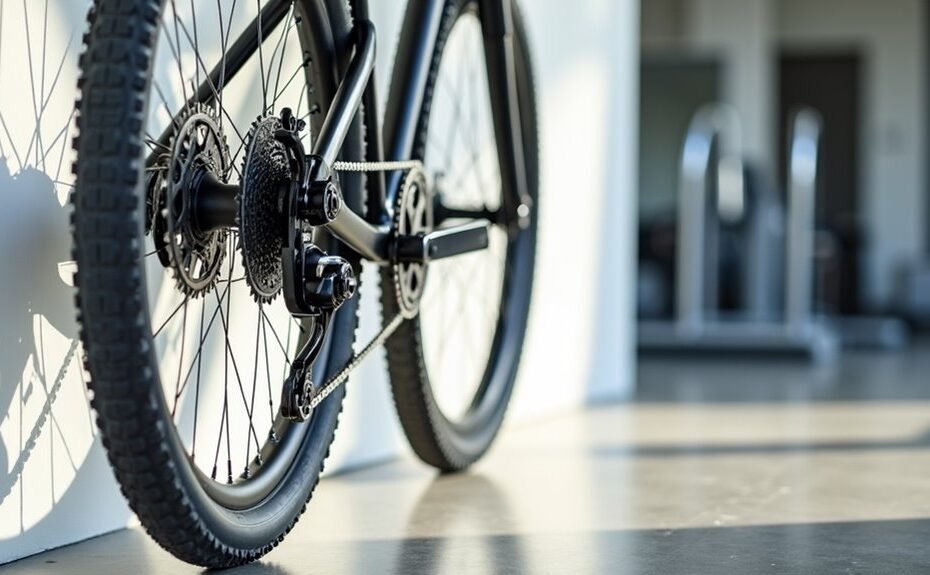Did you know that 78% of bike repairs could be prevented through proper maintenance of moving parts? I've spent two decades maintaining and repairing bikes, and I've learned that a clean, well-lubricated bicycle isn't just about extending its lifespan—it's about safety and performance. While most cyclists understand the importance of basic chain care, there's a complex ecosystem of moving parts that requires attention. In this guide, I'll share professional insights that'll transform your maintenance routine and help you avoid costly repairs while maximizing your bike's potential.
Key Takeaways
- Clean and degrease the drivetrain regularly using appropriate solvents and brushes to prevent wear and maintain shifting performance.
- Lubricate the chain every 100-150 miles with proper lubricants, matching oil-based for wet conditions and Teflon-based for dry.
- Inspect and lubricate brake and derailleur cables, focusing on pivot points and housing for smooth operation.
- Service suspension components every 30-50 hours, including oil changes and seal maintenance for optimal performance.
- Avoid high-pressure washing and over-lubrication, as these can damage bearings and attract dirt to moving components.
Why Maintenance Matters
Reliability forms the cornerstone of an enjoyable cycling experience, which is why bike maintenance isn't just a suggestion – it's essential. I can't stress enough how proper maintenance directly impacts your safety, performance, and wallet.
Let me explain why this matters so much. When you maintain your bike regularly, you're actively preventing mechanical failures that could lead to accidents. You'll catch worn brake pads, loose bolts, or tire issues before they become dangerous problems on the road. I've seen how well-maintained bikes not only perform better but also save riders money in the long run. Local bike shops can provide expert inspections to ensure every component is functioning properly. Regular check-ups help identify potential issues before they develop into major problems.
From a performance standpoint, I know that a clean, well-lubricated bike responds better and makes every ride more efficient. You'll feel the difference in smoother gear shifts, better braking, and improved power transfer.
Plus, when you maintain your bike regularly, you're protecting your investment by extending its lifespan and avoiding costly repairs.
Most importantly, proper maintenance enhances your overall riding experience. I've found that a well-maintained bike simply feels better to ride, whether you're commuting to work or hitting the trails on weekends.
Chain Care Fundamentals
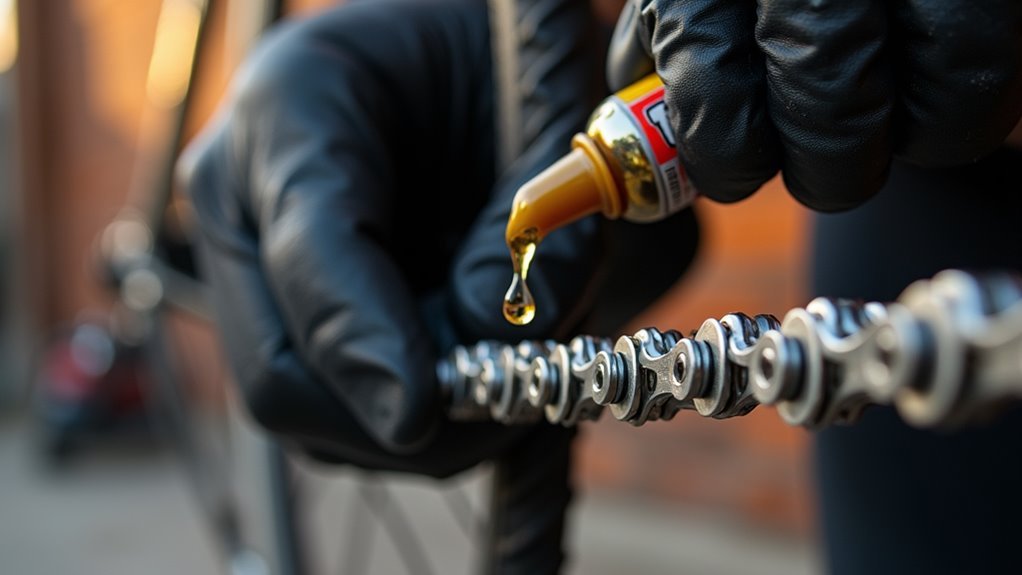
Among all bike maintenance tasks, chain care stands at the heart of keeping your bicycle running smoothly. I recommend lubing your chain every 100-150 miles or weekly for regular riding, and after every ride in wet or dirty conditions. You'll also want to lube when you hear squeaking or spot rust. Regular maintenance and timely chain replacements can prevent costly damage to your cassette and chainring.
I've found that choosing the right lubricant makes a significant difference. For dry and winter conditions, I use oil-based lubes like Tri-Flow or Pro-Link. In dusty environments, I switch to dry or Teflon-based options. Sandy trails require extra attention when selecting lubricants. I avoid WD-40 as it's too light, and I steer clear of products that can gunk up the drivetrain.
When it comes to cleaning, I clean my chain every two to three lube jobs during dry conditions. I use a chain scrubber with degreaser, running it through while the bike's in its highest gear.
After cleaning, I rinse with water, dry thoroughly, and apply fresh lubricant. Remember to wipe off excess lube, as it attracts dirt.
I also use a chain wear indicator to monitor condition and determine when maintenance is needed.
Proper Cleaning Techniques
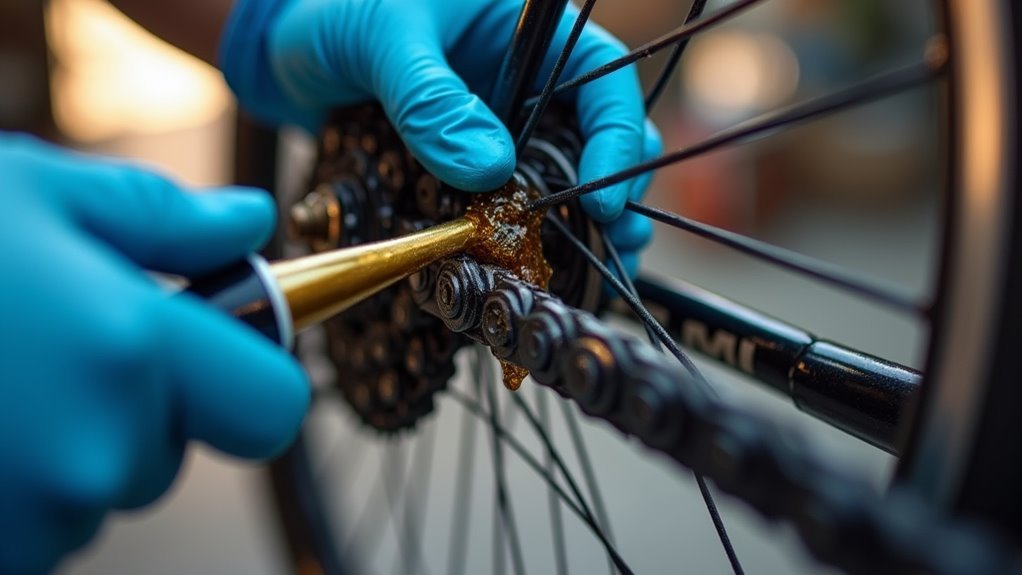
Regular cleaning is essential for extending your bike's lifespan and maintaining peak performance. I recommend starting with a gentle pre-soak using warm water and soap or a biodegradable cleaner. Let it sit for 10-20 minutes to loosen stubborn dirt. Eco-friendly cleaners help protect the environment during bike maintenance.
Don't use high-pressure washers, as they can damage your wheel bearings. Using a workstand makes cleaning much easier and more thorough.
When cleaning specific components, I start with the frame and work my way to the more detailed parts. I use a sponge or bike washing glove for larger surfaces, then switch to smaller brushes for tight spaces.
The drivetrain needs special attention – I use a toothbrush to clean the cassette, chain rings, and front derailleur thoroughly.
After cleaning, I rinse everything with fresh water to remove all detergent residue. I'm particularly careful to dry around shock seals and bearing packs to prevent rust.
For the final touches, I bounce the bike gently to remove trapped water, then use microfiber cloths for drying. I finish with a light coating of PTFE or silicone spray, which helps repel dirt during future rides.
Lubrication Best Practices
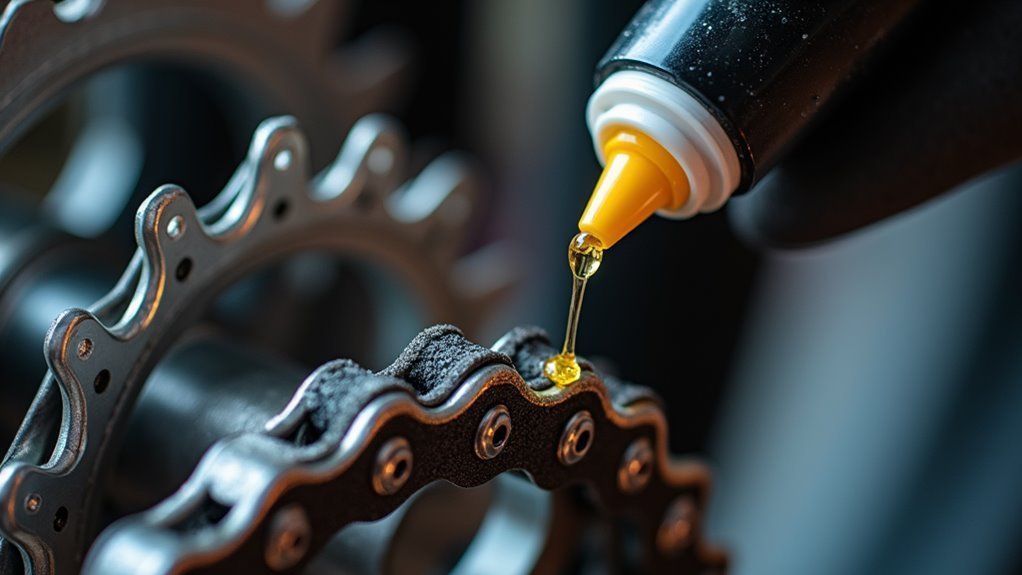
After a thorough cleaning, proper lubrication keeps your bike running smoothly and protects its components from wear.
I'll show you how to lubricate key areas effectively while avoiding common mistakes.
Over-lubricating can actually harm performance and damage parts. Start with your chain, as it's the most critical component. Apply lubricant to the lower chain run while pedaling backward, ensuring even coverage.
Choose dry lubricant for dry conditions and wet lubricant for wet weather. After application, wipe off excess until the chain feels slightly moist to prevent dirt buildup. Small amounts of quality lubricant are sufficient for multiple rides.
Next, focus on pivot points in your brake and derailleur systems. Apply a single drop of lubricant to each moving part using a small brush or spray nozzle.
Don't forget brake levers, jockey wheels, and adjustment barrels. When lubricating brake mechanisms, keep the lubricant away from brake pads and wheel rims.
Remember to use only cycling-specific lubricants – avoid multipurpose oils or WD-40, as they can damage components.
Plan to lubricate your chain every 1-2 months in dry conditions or after riding in rain. For other components, reapply when they begin feeling dry or making noise.
Moving Parts Beyond the Chain
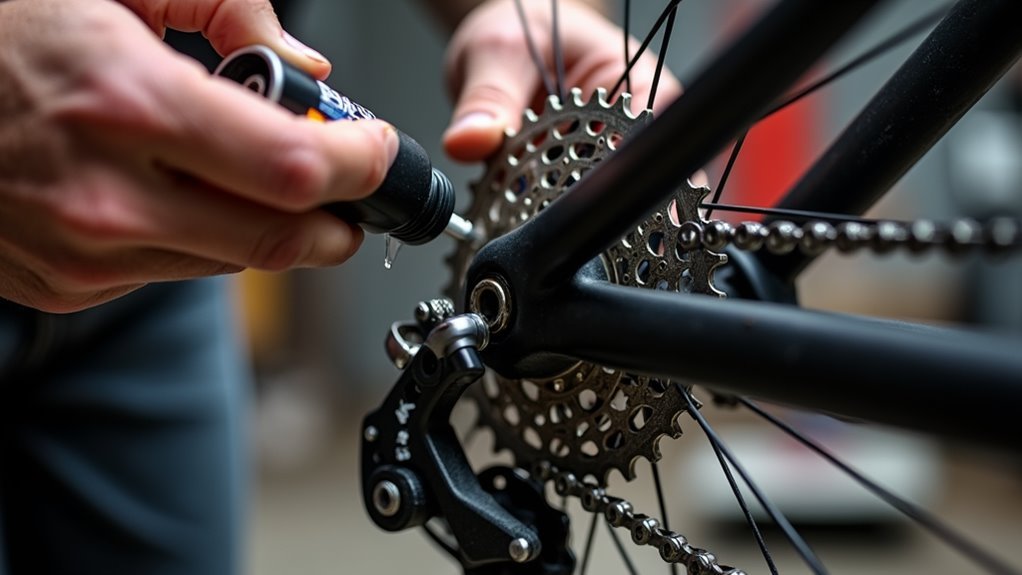
Beyond your chain's care, your bike's other moving parts require consistent attention to maintain peak performance and extend their lifespan.
I'll show you how to focus on the critical components that keep your bike running smoothly.
Let's start with your brake and derailleur systems. I recommend inspecting the cables regularly, especially after wet rides, and applying a light lubricant to prevent sticking. Using environmentally friendly degreasers will help keep your components clean without harming the environment.
Don't forget the lever pivots – a drop or two of lube will keep them operating smoothly. When cleaning disc brakes, I always use isopropyl alcohol and avoid touching the rotors with bare hands to prevent contamination. Natural skin oils can significantly reduce braking effectiveness.
For bikes with suspension, I can't stress enough the importance of regular maintenance. You'll want to service your fork and shock every 30-50 hours of riding, which includes changing the oil and cleaning the seals.
I always clean suspension components with gentle cleaners, avoiding high-pressure water that can damage sensitive bearings. When maintaining seals, I carefully wipe them clean and apply a small amount of lubricant to prevent them from drying out and failing prematurely.
Common Maintenance Mistakes
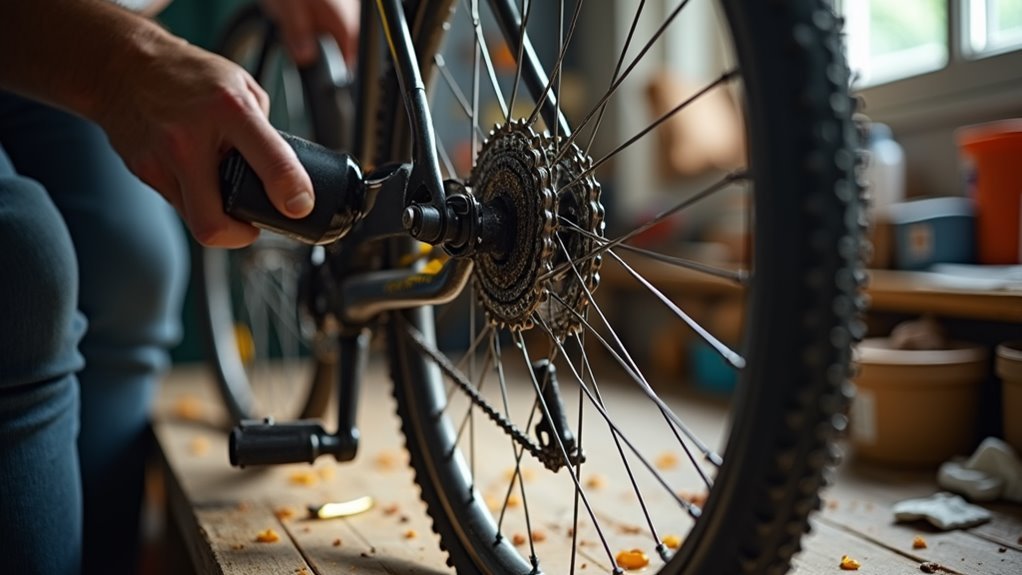
Even with proper maintenance knowledge, I've seen cyclists make mistakes that can damage their bikes. Let me highlight the most critical errors I've encountered and how to avoid them.
When it comes to lubrication, don't use WD-40 on your chain – it's not a proper lubricant and will dry out your chain. Instead, I recommend using a pour-on lube that matches your riding conditions, and always remember to wipe off excess lubricant to prevent dirt accumulation.
Over-tightening bolts is another common mistake I see frequently. Rather than forcing bolts too tight, I suggest using a torque wrench and following manufacturer specifications.
Apply fiber grip paste to clamp areas, and use thread-locking compounds on critical components.
For cable and derailleur adjustments, I've learned to check cable tension and cleanliness before touching those limit screws.
If you're dealing with internal cable routing, there are several helpful tricks to make the job easier.
Tools and Products
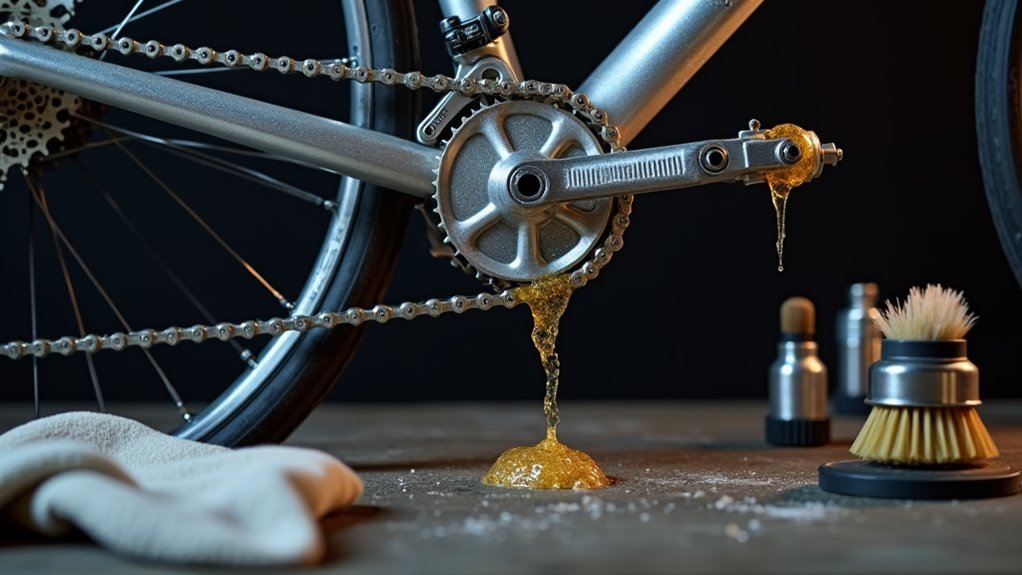
Having the right tools and products makes bike maintenance both easier and more effective. I recommend starting with a quality multi-tool that includes hex wrenches and tire levers – these are essential for basic repairs and adjustments during rides.
You'll also need an all-inclusive brush set for cleaning; I've found the Band of Brushes set particularly useful, with its five specialized brushes targeting different bike components.
For lubrication, you'll need both chain lube and degreaser. I suggest choosing your chain lube based on your riding conditions – wet formula for rainy weather and dry formula for dusty conditions. Remember to lubricate your chain at least monthly, more often if you're riding in challenging conditions.
Don't forget about your derailleurs and brake cables; they need proper lubrication to maintain smooth operation.
While you can handle most maintenance tasks with these basic tools, some components like bottom brackets and hub bearings require professional attention.
I've learned that investing in quality tools and products pays off – they last longer and help preserve your bike's performance, making every ride more enjoyable.
Maintenance Schedule and Tracking
The right tools are only part of successful bike maintenance – you also need a clear schedule to keep your bike running smoothly. I recommend adjusting your maintenance intervals based on how often and where you ride. If you're riding over 100 km weekly or in harsh conditions, you'll need to service your bike twice as frequently as someone doing casual rides.
I've found tracking maintenance through apps like ProBikeGarage incredibly helpful. You can sync your rides from Strava, register your components, and receive automated alerts when it's time for service. For instance, I check my drivetrain every 20-25 hours of riding or biweekly, while I service my suspension every 50 hours or annually.
Before each ride, I always inspect tire pressure, brake blocks, and wheel condition.
Weekly, I clean and lubricate exposed moving parts, particularly the chain and gears. For bigger jobs, I follow component-specific schedules – hydraulic brakes need bleeding every 100 hours or annually, while pedals require periodic bearing checks and fresh grease.
Frequently Asked Questions
Can I Use WD-40 as a Permanent Chain Lubricant?
I don't recommend using WD-40 as a chain lubricant. It's designed as a water displacer, not a long-term lubricant. I suggest using proper bike chain lubricants for better protection and performance.
What Should I Do if My Chain Makes Clicking Noises After Lubrication?
Like a detective on a case, I'd check your chain wear first, then verify derailleur adjustments, and guarantee you're not cross-chaining. If clicking persists, inspect for stiff links.
How Do I Clean My Bike Without a Dedicated Bike Stand?
I recommend flipping your bike upside down to rest on the seat and handlebars. Then clean from top to bottom, using warm soapy water and gentle scrubbing with brushes.
Is It Necessary to Remove the Chain for Deep Cleaning?
While I don't find it strictly necessary to remove the chain, I recommend it for the most thorough cleaning. On-bike cleaning can work well if you're diligent with regular maintenance.
Can I Use Household Oil Instead of Bicycle-Specific Lubricants?
Just as you wouldn't put maple syrup in your car's engine, I strongly advise against using household oils on your bike. They'll corrode components and attract dirt, leading to costly repairs.
